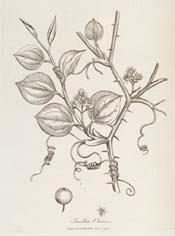

|
Smilax, China
(Smilax China LINN.)
|
Smilax, China
Botanical: Smilax China (LINN.)
Family: N.O. Liliaceae
---Synonym---China.
---Part Used---Root.
---Habitat---Eastern Asia.
It has a hard, large, knotty, uneven rhizome, blackish externally, pale coloured or whitish internally. Stem without support, about 3 feet high, but growing much taller if it has a bush to cling to. Leaves thin, membraneous, round, five-nerved acute or obtuse at each end, mucronate at points. Stipules distinct obtuse; umbels greenish yellow, small ten-flowered; fruit red, size of bird cherry. This is the commercial China root, used as a substitute for Sarsaparilla. It is in large ligneous pieces 2 to 6 inches long and about 2 inches in diameter. Odourless, taste at first slightly bitter and acrid like Sarsaparilla. The root-stocks yield a yellow dye with alum and a brown one with sulphate of iron.
Brazilian or Rio Negro or Lisbon Sarsaparilla is furnished by Smilax Papyracea.
S . Aspera (habitat, South of France, Italy, etc.) yields the Italian Sarsaparilla which has the same properties as the American ones.
S. ovalifolia is used medicinally in India.
S. lanceaefolia is used in India and has very large tuberous root-stocks.
S. glyciphylla is the Australian medicinal Sarsaparilla.
S. macabucha is used in the Philippines for dysentery and other complaints.
S. anceps is the medicinal Sarsaparilla of Mauritius.
In Persia the young shoots of some of the species are eaten as asparagus.
S. pseudo-China and other species are used in basket-making.
S. rotundifolia - Mexican - is said to be a diaphoretic and depurative.
All the Sarsaparillas have medicinal properties and can be used in the same way. Sarsaparilla is efficacious in proportion to its acrid taste. The properties reside chiefly in the cortex, though the bark is generally used.
The name Smilax was used by the Greeks to denote a poisonous tree - others derive the name from Smile, i.e. a cutting or scratching implement, in allusion to the rough prickles on the stem.
In commerce the varieties of Sarsaparillas are grouped as mealy and non-mealy, according to the starch they contain. The farinaceous matter is found under the rind.
The mealy group include Smilax officinalis, Honduras, Caracas, Brazilian, Syphilitica and Papyraceae.
The non-mealy species are Jamaica Sarsaparilla, Mexican, Media and Lima.
The most esteemed varieties are Jamaica and Lima on account of their acrid taste.
See:
(AMERICAN) SPIKENARD
SARSAPARILLA, AMERICAN
SARSAPARILLA, CARACAO
SARSAPARILLA, JAMAICA
SARSAPARILLA, INDIAN
SARSAPARILLA, WILD
[Top]
Common Name Index
A MODERN HERBAL Home Page
Bear in mind "A Modern Herbal" was written with the conventional wisdom of the early 1900's. This should be taken into account as some of the information may now be considered inaccurate, or not in accordance with modern medicine.
© Copyright Protected 1995-2004 botanical.com

|

